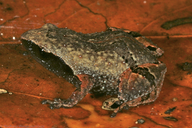|
Pseudophilautus semiruber (Annandale, 1913)
| family: Rhacophoridae subfamily: Rhacophorinae genus: Pseudophilautus |
| Species Description: Manamendra-Arachchi K & Pethiyagoda R 2005 The Sri Lankan shrub-frogs of the genus Philautus Gistel, 1848 (Ranidae:Rhacophorinae), with description of 27 new species. Raffles Bull Zool Suppl. 12:163-303. | |
 © 2012 Dr. Madhava Meegaskumbura (1 of 1) |
|
|
|
Description P. semiruber can be distinguished from its close relatives by its small size when adult (12-13.4 mm snout-vent length), rounded canthal edges, distinct tympanum, lack of a vomerine ridge, weakly defined supratympanic fold, and smooth skin on its underside (Meegaskumbura et al. 2011). Coloration: In life, P. semiruber is generally a gray-brown color when viewed from above. The front half of the head is ashy brown. The face and lips are ash-colored. The area from the interorbital region through the back of the dorsum is gray. The flanks are ash-brown with occasional white patches outlined in red. The mid-dorsal ridge is red. The upper portions of the arms, thighs, and feet are red, with darkened crossbars on the hind limbs. The undersides of the thighs are an orange-red, with white patches. The throat is ashy-brown with white patches while the chest and belly are reddish brown with white patches. When preserved in ethanol, the gray and ash-brown colors appear as a dark brown. The white patches become yellowish, and all red coloration fades to brown. The mid-dorsal ridge appears pale brown (Meegaskumbura et al. 2011). Distribution and Habitat Country distribution from AmphibiaWeb's database: Sri Lanka
P. semiruber inhabits the montane forest of the area around Pattipola and Agra-Bopath in Sri Lanka. The elevation of this region is around 1800 m (Agra-Bopath 1750 m, Pattipola 1829 m) above sea level. P. semiruber inhabits the shaded leaf litter on the forest floor (Meegaskumbura et al. 2011). Life History, Abundance, Activity, and Special Behaviors Possible reasons for amphibian decline General habitat alteration and loss Comments P. semiruber is most closely related to P. simba (4% different in 16s mtDNA sequences), which is slightly larger (12.6-15.6 mm SVL in P. simba vs. 12-13.4 mm SVL in P. semiruber). There is one other diminutive Pseudophilautus species, P. tanu (13.5-13.9 mm SVL), which is more distantly related than P. simba, and is a nocturnal shrub dweller while both P. semiruber and P. simba are diurnal and inhabit the leaf litter (Meegaskumbura et al. 2011).
References
Meegaskumbura, M., Manamendra-Arachchi, K., Bowatte, G., and Meegaskumbura, S. (2012). ''Rediscovery of Pseudophilautus semiruber, a diminutive shrub frog (Rhacophoridae: Pseudophilautus) from Sri Lanka.'' Zootaxa, 3229, 58-68. Originally submitted by: John Cavagnaro (first posted 2012-05-08) Edited by: Michelle S. Koo (2012-11-20) Species Account Citation: AmphibiaWeb 2012 Pseudophilautus semiruber <https://amphibiaweb.org/species/6484> University of California, Berkeley, CA, USA. Accessed Jan 27, 2025.
Feedback or comments about this page.
Citation: AmphibiaWeb. 2025. <https://amphibiaweb.org> University of California, Berkeley, CA, USA. Accessed 27 Jan 2025. AmphibiaWeb's policy on data use. |


 Map of Life
Map of Life